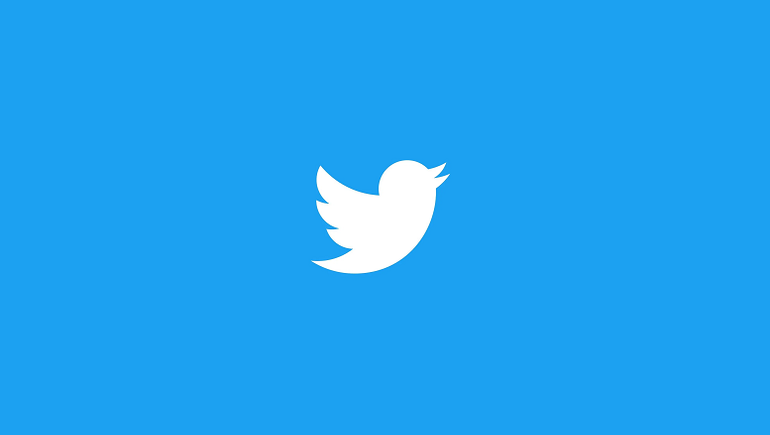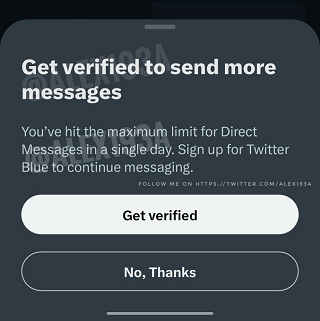SOCIAL
Twitter Tests New Restrictions on DMs to Combat Message Spam

After upping its efforts to combat general spam in user feeds by prioritizing Twitter Blue users in content rankings in the app, Twitter’s now switching its attention to DM misuse, with a range of new measures designed to limit the ways that messages can be used for mass sends, flooding inboxes with random junk that users then need to clear out.
First off, as we reported last week, Twitter’s testing out new restrictions on DM sending, with Twitter Blue users soon set to be the only ones that’ll be allowed to send DM requests to users who don’t follow them in the app.
That’ll significantly restrict people’s capacity to engage in DM spam – though it’ll also impact businesses using Twitter for customer service, and various others who use Twitter DMs to reach out to potential contacts or collaborators.
Of course, you’ll be able to get around this, by paying $8 per month, which Twitter maintains is a form of user verification, enough to weed out spammers at least. And if more people get verified, more people can engage via DM, the impact is reduced, etc.
Elon Musk says that this new element will likely be rolled out sometime this week.
In addition to this, Twitter’s also looking to implement limits on the amount of DMs that non-subscribers can send per day.

As you can see in this example, shared by app researcher Alessandro Paluzzi, Twitter will soon stop users from sending any DMs once they reach a certain limit, with the current daily limit, Paluzzi says, pegged at 500.
Which is a lot. If you’re sending 500 DMs per day, you probably should be paying – but Paluzzi also notes that this number could be much smaller once this restriction is eventually rolled out.
The combined measures will significantly impact DM spammers – though they too will also be able to pay the $8 per month, and keep on sending. I guess, the risk here is that they get reported and lose their verification as a result – or Twitter makes money from such either way, so it becomes less of a problem for Elon and Co.
But it should work to reduce DM spam, which could be another step towards both improving the messaging experience in the app, while also prompting more people to sign up to Twitter Blue, a win-win for Twitter itself.
As noted, that may have other, unintended impacts, depending on how you use DMs. But Twitter’s response will be to push users towards Twitter Blue, which Elon Musk maintains is the best solution for addressing Twitter’s spam and bot issues.
Which it probably isn’t, but if more people do sign up, it has the potential to address several of Twitter’s challenges in one measure.
Twitter needs more revenue, with Twitter’s overall ad revenue down 40% year-over-year, while it also wants to diversify its income streams, so it doesn’t have to implement moderation and censorship at the behest of ad partners (ad revenue still makes up around 90% of Twitter’s income). And then there’s the verification element. Proper verification would involve confirmation of identity via Government-issued ID, but that also requires manual checking, and thus, additional labor time, so Twitter’s using what it calls ‘payment verification’ as a proxy for ID confirmation – i.e. if a user has a phone number, and a connected bank account, it must be a real person, while bot armies will be harder to construct if they have to pay for each account.
In theory, all of this makes sense. In reality, however, not enough people are paying for Twitter Blue to make this an effective option.
Right now, around 0.28% of Twitter users have signed onto the program, which is nowhere near enough to make this a viable solution on any of these fronts. But Twitter’s sticking with it – though a more effective solution would likely be free verification, via government-issued ID, as opposed to having to pay for such.
LinkedIn’s looking to implement this via a third-party provider, which will reduce manual checking and confirmation on its end. That’ll likely see a lot more take-up, though it’s still a heap of manual work, and Twitter, right now, has less capacity for such than ever, with around 80% fewer staff than this time last year.
So it’ll need to stick with Twitter Blue as its verification stream, for now at least, which will see it continue to implement new measures like this to make the app less functional for non-subscribers, in the hopes that more of them will just pay and be done with it.
I doubt that’s going to happen, but at least Twitter will know, one way or another, whether this is a workable solution in the end.
In other Twitter DM news, it’s also increasing its group chat limit from 50 to 100 people.
Is your group chat running out of space? Starting today, group Direct Messages can include up to 100 people. We’ll increase this limit further over the coming weeks.
— Twitter Support (@TwitterSupport) June 13, 2023
The broader social media trend towards messaging interactions, as opposed to public posting in feeds, has prompted every app to reconsider its messaging elements, and Twitter will be hoping that a bigger group DM limit will provide more capacity for discussion – while Elon also recently agreed with a user suggestion that Twitter Circles should be culled in favor of better DM tools.
Seems like that could be the next thing on the Twitter chopping block.
SOCIAL
Snapchat Explores New Messaging Retention Feature: A Game-Changer or Risky Move?

In a recent announcement, Snapchat revealed a groundbreaking update that challenges its traditional design ethos. The platform is experimenting with an option that allows users to defy the 24-hour auto-delete rule, a feature synonymous with Snapchat’s ephemeral messaging model.
The proposed change aims to introduce a “Never delete” option in messaging retention settings, aligning Snapchat more closely with conventional messaging apps. While this move may blur Snapchat’s distinctive selling point, Snap appears convinced of its necessity.
According to Snap, the decision stems from user feedback and a commitment to innovation based on user needs. The company aims to provide greater flexibility and control over conversations, catering to the preferences of its community.
Currently undergoing trials in select markets, the new feature empowers users to adjust retention settings on a conversation-by-conversation basis. Flexibility remains paramount, with participants able to modify settings within chats and receive in-chat notifications to ensure transparency.
Snapchat underscores that the default auto-delete feature will persist, reinforcing its design philosophy centered on ephemerality. However, with the app gaining traction as a primary messaging platform, the option offers users a means to preserve longer chat histories.
The update marks a pivotal moment for Snapchat, renowned for its disappearing message premise, especially popular among younger demographics. Retaining this focus has been pivotal to Snapchat’s identity, but the shift suggests a broader strategy aimed at diversifying its user base.
This strategy may appeal particularly to older demographics, potentially extending Snapchat’s relevance as users age. By emulating features of conventional messaging platforms, Snapchat seeks to enhance its appeal and broaden its reach.
Yet, the introduction of message retention poses questions about Snapchat’s uniqueness. While addressing user demands, the risk of diluting Snapchat’s distinctiveness looms large.
As Snapchat ventures into uncharted territory, the outcome of this experiment remains uncertain. Will message retention propel Snapchat to new heights, or will it compromise the platform’s uniqueness?
Only time will tell.
SOCIAL
Catering to specific audience boosts your business, says accountant turned coach

While it is tempting to try to appeal to a broad audience, the founder of alcohol-free coaching service Just the Tonic, Sandra Parker, believes the best thing you can do for your business is focus on your niche. Here’s how she did just that.
When running a business, reaching out to as many clients as possible can be tempting. But it also risks making your marketing “too generic,” warns Sandra Parker, the founder of Just The Tonic Coaching.
“From the very start of my business, I knew exactly who I could help and who I couldn’t,” Parker told My Biggest Lessons.
Parker struggled with alcohol dependence as a young professional. Today, her business targets high-achieving individuals who face challenges similar to those she had early in her career.
“I understand their frustrations, I understand their fears, and I understand their coping mechanisms and the stories they’re telling themselves,” Parker said. “Because of that, I’m able to market very effectively, to speak in a language that they understand, and am able to reach them.”Â
“I believe that it’s really important that you know exactly who your customer or your client is, and you target them, and you resist the temptation to make your marketing too generic to try and reach everyone,” she explained.
“If you speak specifically to your target clients, you will reach them, and I believe that’s the way that you’re going to be more successful.
Watch the video for more of Sandra Parker’s biggest lessons.
SOCIAL
Instagram Tests Live-Stream Games to Enhance Engagement

Instagram’s testing out some new options to help spice up your live-streams in the app, with some live broadcasters now able to select a game that they can play with viewers in-stream.
As you can see in these example screens, posted by Ahmed Ghanem, some creators now have the option to play either “This or That”, a question and answer prompt that you can share with your viewers, or “Trivia”, to generate more engagement within your IG live-streams.
That could be a simple way to spark more conversation and interaction, which could then lead into further engagement opportunities from your live audience.
Meta’s been exploring more ways to make live-streaming a bigger consideration for IG creators, with a view to live-streams potentially catching on with more users.
That includes the gradual expansion of its “Stars” live-stream donation program, giving more creators in more regions a means to accept donations from live-stream viewers, while back in December, Instagram also added some new options to make it easier to go live using third-party tools via desktop PCs.
Live streaming has been a major shift in China, where shopping live-streams, in particular, have led to massive opportunities for streaming platforms. They haven’t caught on in the same way in Western regions, but as TikTok and YouTube look to push live-stream adoption, there is still a chance that they will become a much bigger element in future.
Which is why IG is also trying to stay in touch, and add more ways for its creators to engage via streams. Live-stream games is another element within this, which could make this a better community-building, and potentially sales-driving option.
We’ve asked Instagram for more information on this test, and we’ll update this post if/when we hear back.
-

 MARKETING7 days ago
MARKETING7 days agoEffective Communication in Business as a Crisis Management Strategy
-

 SEARCHENGINES7 days ago
SEARCHENGINES7 days agoGoogle Won’t Change The 301 Signals For Ranking & SEO
-

 SEO6 days ago
SEO6 days agobrightonSEO Live Blog
-

 PPC7 days ago
PPC7 days ago9 Ecommerce Trends to Boost Your Business in 2024
-

 SEO5 days ago
SEO5 days agoGoogle March 2024 Core Update Officially Completed A Week Ago
-

 WORDPRESS5 days ago
WORDPRESS5 days ago9 Best WooCommerce Multi Vendor Plugins (Compared)
-
SEARCHENGINES6 days ago
Daily Search Forum Recap: April 25, 2024
-

 WORDPRESS6 days ago
WORDPRESS6 days agoYour New Favorite Way to Develop WordPress Locally – WordPress.com News














![The Current State of Google’s Search Generative Experience [What It Means for SEO in 2024] person typing on laptop with](https://articles.entireweb.com/wp-content/uploads/2024/04/The-Current-State-of-Googles-Search-Generative-Experience-What-It.webp-80x80.webp)